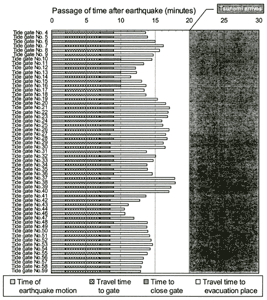|
USE OF GATES AGAINST TSUNAMI DISASTER
In this section, the probability of whether gates can be closed in the event of a Nankai tsunami coming is examined.
Condition of gate management
To begin with, the condition of gate management was researched. Figure 6 shows the results from this. According to these results, 14% of gates cannot be closed due to corrosion and other factors. 25% of gates had some troubles to close. For example, they are too heavy to close, cannot be closed quickly, are hindered by deposits of sand, and so on. Thus, in Usa town, 40% of gates may not be able to be closed in the event of a tsunami approaching.
Figure 6. Condition of gate management
In addition, in some other regions, the condition of gate management was researched. It was found that about 40% of gates have some troubles to be closed, as in Usa town. Therefore, present gate management is inadequate to close them when a tsunami comes, and it must be stressed that present gate condition and gate management must be improved.
Judgment of gate management from gate operator's schedule
It was ascertained whether or not gate operators could close a gate and evacuate to a safe place before a tsunami came. The assumed conditions in this judgment are explained as follows.
After an earthquake occurs, earthquake motion continues for two minutes. A gate operator comes to the gate within five minutes, and closes the gate. The time required to close a gate depends on the gate type. The relationship between gate type and time to close gate is shown in Table 1. A gate operator's refuge time from the gate to an evacuation place is given as the distance divided by a walking speed of 1 meter per second.
Table 1. Relationship between gate type and time to close
| |
Gate type |
Basis of time to close gate |
Time to close |
| Flood gate |
Flap type |
No time required to close. |
0.0 min |
| Other types |
Management ledger & interview (lifting height) / (closing gate speed) |
0.3 m/min* |
| Tide gate |
Sliding door type |
Time to close in disaster prevention training |
2.0 min |
| Hinged door type |
Time to close in disaster prevention training |
1.5 min |
| Rotating handle type |
Interview |
3.0 min |
|
|
| *; In case of emergency, 1.0m/min |
The judgment is based on whether or not these tasks can be completed before tsunami arrival. When a gate operator cannot finish these tasks before tsunami arrival, it is estimated not only that the gate operator would suffer from injury or death, but also an unclosed gate would increase tsunami damage.
Tide gate
At first, Figure 7 shows the time schedule of a tide gate operator. Tsunami arrival time was calculated to be 20 minutes after earthquake occurrence. The solid gray area in Figure 7 shows the time after tsunami arrival. All tide gates in Usa can be closed before a tsunami comes. But some of them cannot be closed leaving a sufficient safety margin before a tsunami comes. So, some additional measures are needed (i.e., to upgrade the evacuation routes, etc.).
| (Enlarge: 132KB) |
 |
Figure 7. Time schedule of tide gate operators
Flood gate
Next, the time schedule of a floodgate operator is shown. Figure 8 shows the total time needed for closing gate No.2 and No.3 exceeds tsunami arrival time. This means that if a gate operator closes the gate, he will be at high risk of injury or death due to the tsunami. Therefore, these flood gates require some countermeasures to rectify this situation.
Figure 8. Time schedule of flood gate operators
In the next section, the effect of both attaching an emergency closing system and remote control system are estimated.
Attaching an emergency downward closing system
In case of attaching an emergency downward closing system, gate closing speed increases from 0.3 m/min to 1.0 m/min. As a result, in Figure 9, the total time to close gate No.3 is reduced and, as a result, the operator can close it before a tsunami arrives. But, the total time for No.1 and No.2 gates does not decrease as much as that for No.3 gate.
Figure 9. Time schedule of flood gate operators with an emergency downward
closing system attached
Installation of a remote control system
In case of introducing a remote control system, gate operators do not need to go to a gate after an earthquake. As a result, gate closing time for gates No.1 and No.2 was reduced, and it made closing the gate both safe and fast. But, in a case of power failure or disconnection due to an earthquake, there is some risk of system malfunction due to its reliance on an external power source.
Figure 10. Time schedule of flood gate operators after installation of remote
control system
|